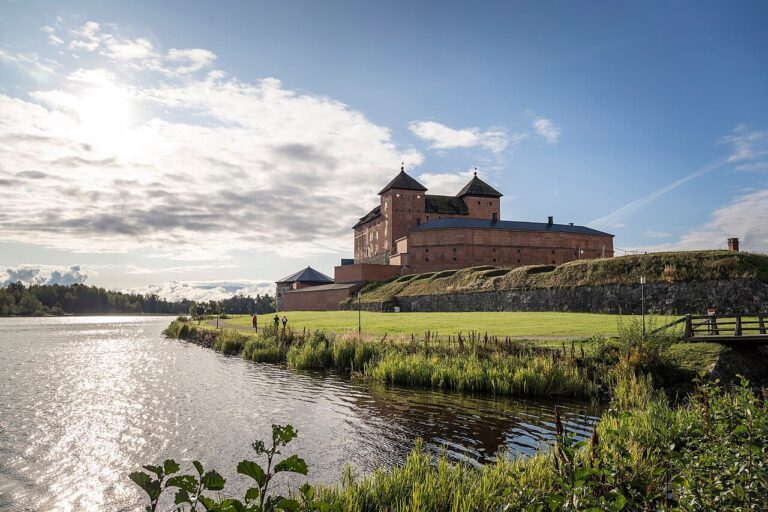The Best Castles & Palaces in Norway
Norway is the country of fjords,Vikings, and fairytale castles. You may not realize it, but this Nordic country is packed with historic fortresses, Royal castles & palaces, and grand manor houses.
Norway has a long and rich history. The Norwegian Kingdom was established in 872, but it has also been part of the Kingdom of Denmark-Norway and it was in a personal union with the Kingdom of Sweden. It has fought invasions from Sweden and a German invasion in the Second World War. But now it is one of the best European countries to visit with its splendid nature and picturesque castles.
These are the best castles and palaces in Norway that you can visit ranging from the 13th to the 20th century.

The Royal Palace Oslo
Located at the end of Karl Johans gate in the center of Oslo you can find the Royal Palace of Oslo. The 19th century palace, designed by Danish architect Hans Linstow, is the official residence of the Norwegian monarch.
The palace is surrounded by the Royal Palace Park, which is one of the largest parks of Oslo.
Where: Oslo
Built: 1825
Style: Neoclassicism
Visitor information: The palace is open in the Summer season
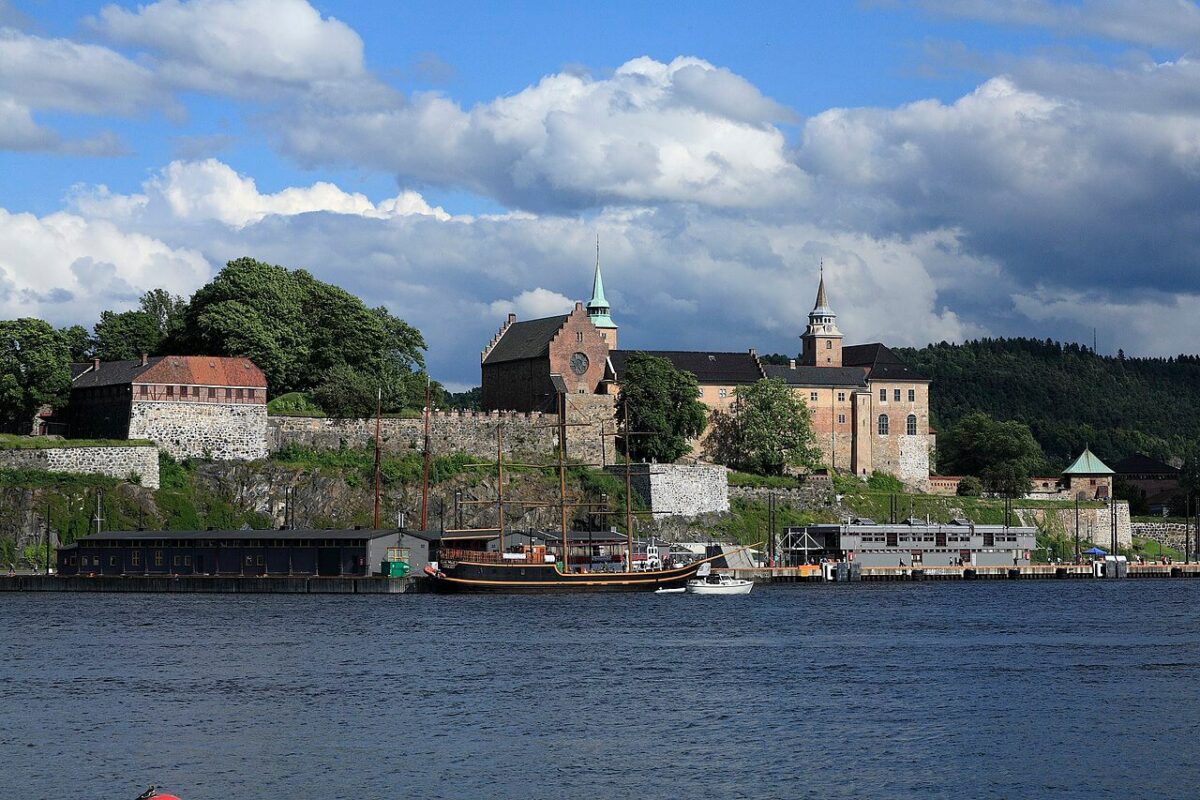
Akershus Castle or Akershus Fortress
Akershus Fortress is a medieval castle in Oslo that was commissioned by King Haakon V in 1299. The castle was built in a strategic location at the end of the headland. It was built to protect the region and also served as a Royal residence.
The castle has often been under siege, mainly by Swedish forces. The Danish/Norwegian King Christian IV renovated the castle after the great fire of Oslo and turned it into a Renaissance castle. During World War II it was occupied by German forces.
The fortress is still a military base but it also houses the Norwegian Armed Forces Museum and the Norway’s Resistance Museum. The castle also houses the Royal Mausoleum, the final resting place of several Norwegian Royal figures.
Where: Oslo
Built: 1299
Style: Renaissance
Visitor information: The castle is open daily from 06:00–21:00
Fredriksten Fortress
Fredriksten Fortress is the largest and most important border fortress in Norway. The 17th century castle was built as the replacement of Bohus fortress after the province of Bohuslän was lost to Sweden.
From the fortress, you have a spectacular over the city of Halden and the fjord. The castle also has a museum where you can learn more about the history of the fortress. Around the fortress there are also forest and nature trails.
Where: Halden
Built: 1661
Visitor information: The castle is open to visitors there are guided tours and audio tours available.

Gamlehaugen Castle
Gamlehaugen is the official residence of the Norwegian monarch in Bergen. The history of Gamlehaugen goes back to the Middle Ages with many wealthy and influential residents of Bergen who have lived here.
The current house was built by its last private owner, Christian Michelsen. The politician (he was Prime Minister of Norway) and shipping magnate asked Jens Zetlitz Monrad Kielland to design a home in Scottish baronial style. The surrounding farmlands were converted into an English park by Olav Moen. After Michelsen’s death the state bought the property.
Where: Bergen
Built: 1899
Style: Scottish baronial
Visitor information: the state rooms and Christian Michelsen’s office are open to visitors in the Summer months.

Oscarshall Palace
Oscarshall Palace is a pleasure palace or summer palace on the peninsula of Bygdøy in Oslo. The palace was built for King Oscar I and Queen Joséphine after a design by Johan Henrik Nebelong.
The interiors of the palace are decorated by many Norwegian contemporary artists. The palace and its surrounding park are a fine example of the National Romantic style.
Where: Oslo
Built: 1847-1852
Style: neo-gothic
Visitor information: The palace is open to visitors in the Summer months

Steinvikholm Castle
Steinvikholm Castle is an island fortress in the Trøndelag county in Norway. The fortress is the largest construction built in the Middle Ages in Norway. The fortress was built by Olav Engelbrektsson, Norway’s last roman catholic archbishop. It became the Roman Catholic Church’s military stronghold in Norway (together with Nidarholm Abbey).
The fortress is now the site of the midnight opera, Olav Engelbrektsson.
Where: Skatval
Built: 1525-1532
Style: Fortress
Visitor information: the fortress is open to visitors in the Summer months

Bergenhus Fortress
Bergenhus Fortress is one of the oldest and best-preserved stone fortifications in Norway. The oldest parts of the fortress date back to the 1240s and new buildings were added until World War II.
Today, the fortress is still in use 220 military and civilian personnel have the fortress as their everyday place of work. But it is also used as an event or concert venue.
The most important buildings of the fortress are Haakon’s Hall, a medieval stone hall, and the Rosenkrantz Tower, a medieval tower that contained dungeons and residential rooms for the governor (and it was later used as a magazine for gunpowder).
Where: Bergen
Built: 1240s-World War Two
Visitor information: the fortress is open to visitors free of charge.
Vardøhus Fortress
Vardøshus Fortress is the world’s northernmost fortress. The first fortress was built by King Håkon V Magnusson in 1307 to protect to north-eastern area of the Norwegian realm.
Throughout the centuries new additions to the fortress have been built. The fortress didn’t see enemy action until the 20th century During the First World War the fortress was on active anti-invasion duty and during the Second World War the fortress was used as an anti-aircraft site as Haakon a Prisoner of War camp.
Where: Vardø
Built: From 1306 onwards
Visitor information: The fortification is open to visitors and houses a museum
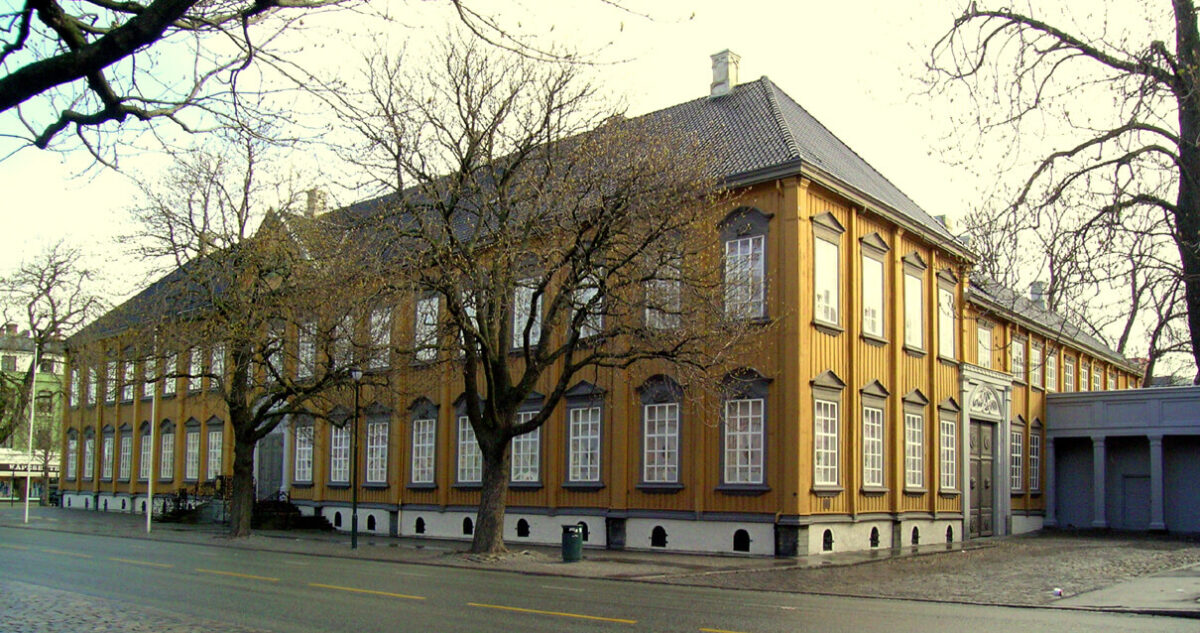
Stiftsgården
Stiftsgården is the official residence of the King of Norway in Trondheim. The palace is located on the city’s most important thoroughfare, the Munkegaten.
The 18th century palace has 140 rooms, making it possible that this is the largest wooden building in Northern Europe.
The palace was built in 1774 for Cecilie Christine Schøller, who was descended from noble families in Denmark. Since 1804, the palace has been the place of residence for the Norwegian Royal family (and in the early 20th century it became exclusively a Royal palace).
Where: Trondheim
Built: 1774
Style: Baroque, Rococo, Neoclassicism
Visitor information: the palace is open to visitors in the Summer months through guided tours (in Norwegian and English)
Barony Rosendal
Barony Rosendal is a 17th century estate and manor house in Kvinnherad. The estate was built by Ludvig Holgersen Rosenkrantz and his wife Karen Andersdatter Mowatt.
In 1678, King Christian V of Denmark and Norway granted the estate the status of a barony, the only one in Norway. In 1850, a romantic garden was planted around the house.
The house was a cultural hotspot, with authors (like Henrik Ibsen) painters (Hans Gude and Anders Askevold), and musicians (Edvard Grieg and Ole Bull) visiting the house.
Today, the house is owned by the University of Oslo and it’s now the Baroniet Rosendal Museum. A guided tour of the preserved home will lead you through different epochs. The garden is known as the most beautiful Victorian garden in Norway with 2000 roses that are in bloom from June to November.
Where: Kvinnherad
Built: 1661
Visitor information: the house is open in the Summer months.
Kristiansten Fortress
Located east of the city Trondheim stands Kristiansten Fortress, named after King Christian V of Denmark and Norway. In 1681, after the city fire of Trondheim, the fortress was built to protect the city against attacks from the east. In 1718, in the final years of the Great Northern War, the fortress came under attack by Swedish forces.
In the Second World War the fortress was used by the Nazi forces. 23 Norwegian patriots were executed inside the fortress.
From the fortress, you can see the “strandlinja” a topographical line along the hills of the Bymarka which was formerly beaches and sea cliffs.
Where: Trondheim
Built: 1681-1685
Visitor information: The fortress is open to visitors. You can visit the dungeons and there is a museum.
Sverresborg Castle
Sverresborg (or Sverre Sigurdsson’s Castle) is a fort and residence built in the medieval city Nidaros (now Trondheim) by King Sverre Sigurdsson.
Sverresborg castle ruins is now part of the Sverresborg Trøndelag Folk Museum, an open-air museum that is one of the largest cultural history museums in Norway.
Where: Trondheim
Built: 1182
Visitor information: the museum is open to visitors. Visit the website for more information.

Fritzøehus
Fritzøehus is the largest private residence in Norway. The manor house was designed by Jacob Wilhelm Nordan in the Renaissance Revival architecture style.
The estate has been owned by the Treschow family since its construction in 1865. In total the manor house has 75 rooms plus 21 basement rooms.
The house stands in Fritzøehus park, a designated conservation area for the purpose of preserving the large beech forests and the distinctive landscape. In the English-style park you can also find walnut, fir, and spruce trees as well as a water fountain and a bear sculpture by Anne Grimdalen. Where: Larvik
Built: 1865
Style: Renaissance Revival
Visitor information: the estate is privately owned and not open to the public.
Audunborg Castle Ruins
Audunborg was a fortification on the shores of the Jølstravatn near the village of Alhus. The castle was built by Audun Hugleiksson, a Norwegian nobleman in the late 13th century.
The stone castle is one of two examples of a private stone castle in Norway. The ruins of the castle were excavated in 1934 by Gerhard Fischer. It is thought that the castle was modelled after the Haakonshallen in Bergen (though not as big).
In 1960, a memorial was placed at the site of Audunborg. The memorial, designed by Jørgen P. Solheimsnes, shows the baron’s seal.
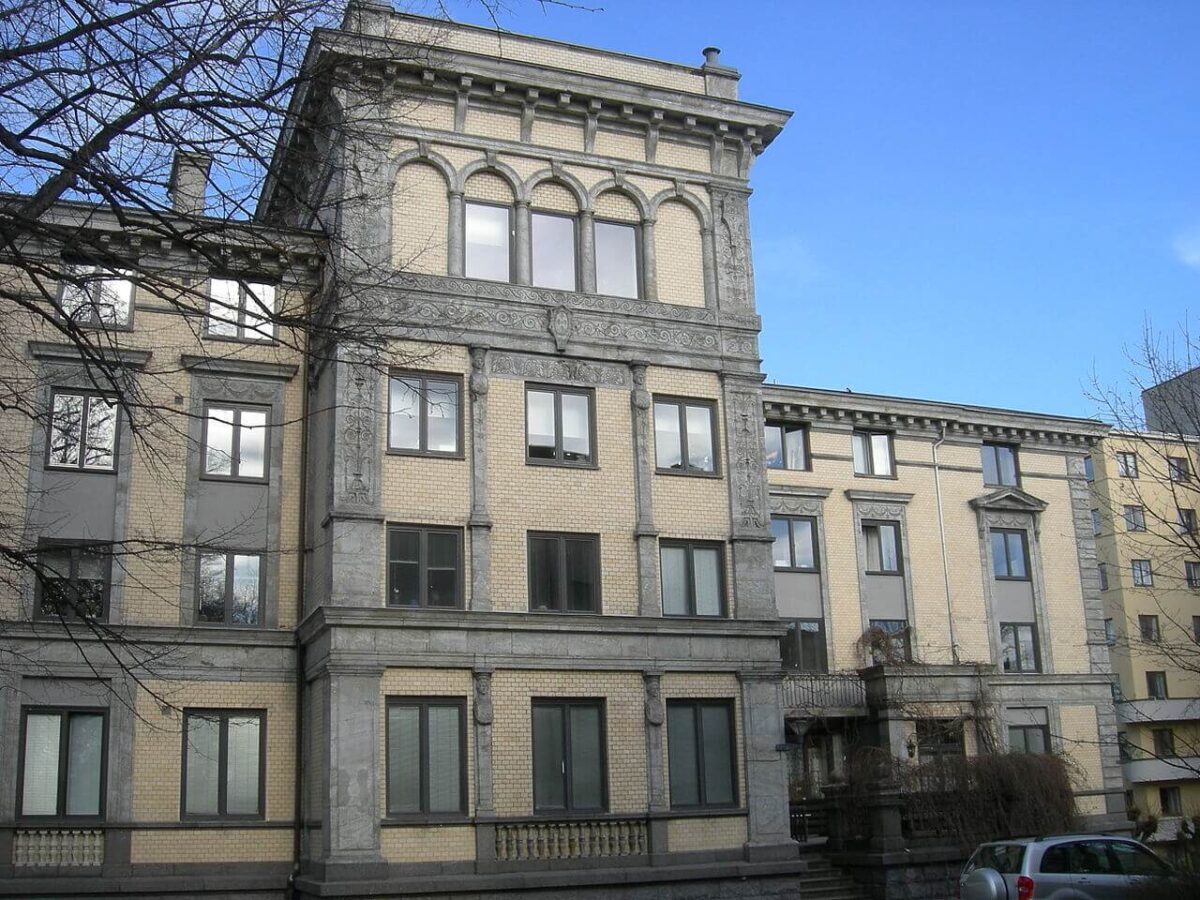
Egeberg Castle
Egeberg Castle in Oslo was once the largest private residence in the city. The 1600 square meter building is located over two floors and a tower section. When the home was built the house was surrounded by a big park that offered views over the city and harbor.
The house was built during the turn of the century for Einar Westye Egeberg after a design by Halfdan Berle. The total construction cost in 1901 was more than 1 million dollars (12 million kroner). Exclusive materials were used to build the house such as granite and soapstone.
In the 1930s the house was sold after which it was expanded and converted into apartments.
Where: Oslo
Built: 1899-1901
Style: Italian Renaissance

Tønsberg Fortress
Located in the oldest town of Norway, Tønsberg, you can find the ruins of e medieval fortress and castle. For over 300 years, the fortress protected the city from invasion.
On the site you can find the ruins of the Castrum Tunsbergis, which was the biggest castle in Norway in the 13th century. There is also a 19th century tower that was built as a memorial to the historic fortress. On the sides of the tower are the gilded signatures of the three modern Kings of Norway (Haakon VII, Olav V, and Harald V).
From the fortress you have a panoramic view over the city.
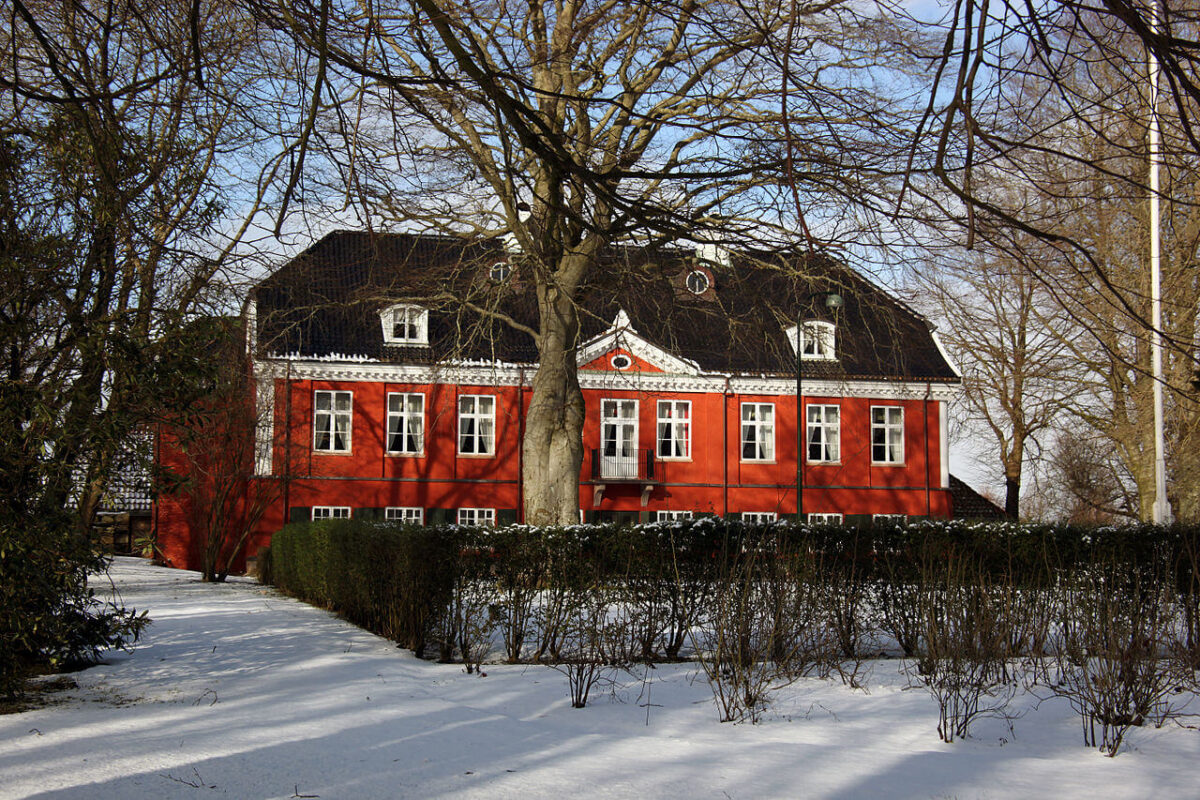
Ledaal
Ledaal is a manor house that served as the official residence of the King of Norway in Stavanger. The house was built between 1799 and 1803 for Gabriel Scanche Kielland (great grandfather of author Alexander Kielland).
The house shows a good insight into the lives of the upper class in the 19th century. The interiors are richly decorated with Rococo, Louis XVI, Empire, and Biedermeier furniture.
Today, the house functions as a museum and Royal residence.
Where: Stavanger
Built: 1799
Visitor information: the museum is open to visitors. Visit the website for more information.
Oscarsborg Fortress
Oscarsborg Fortress is a 19th century fortress in the Oslofjord near Drøbak. The fortress was built to protect Oslo from attacks over sea. In 1890, the fortress was expanded so it could also protect the city from attacks over land. It was considered as one of the strongest fortresses in northern Europe with a defensive line that stretched 10km from the Heer.
Today, the fortress (and the island on which it stands) is a great destination in the Summer months for families and those who are interested in nature, culture, and history. The Oscarsborg Fortress Museum organizes guided tours to lean more about the historiy of the place.

Bogstad Manor
Bogstad Manor is a manor house in Oslo. Originally Bogstad was a farm but between 1760 and 1780 the Classicist manor house was built. The house was owned by notable people like Norwegian Prime Minister Peder Anker.
Today, the house is used as a historic house museum with furniture, paintings, and chandeliers from the period 1750–1850.
Where: Oslo
Built: 1760
Style: Classicist
Visitor information: the museum is open to visitors in the Summer months.
